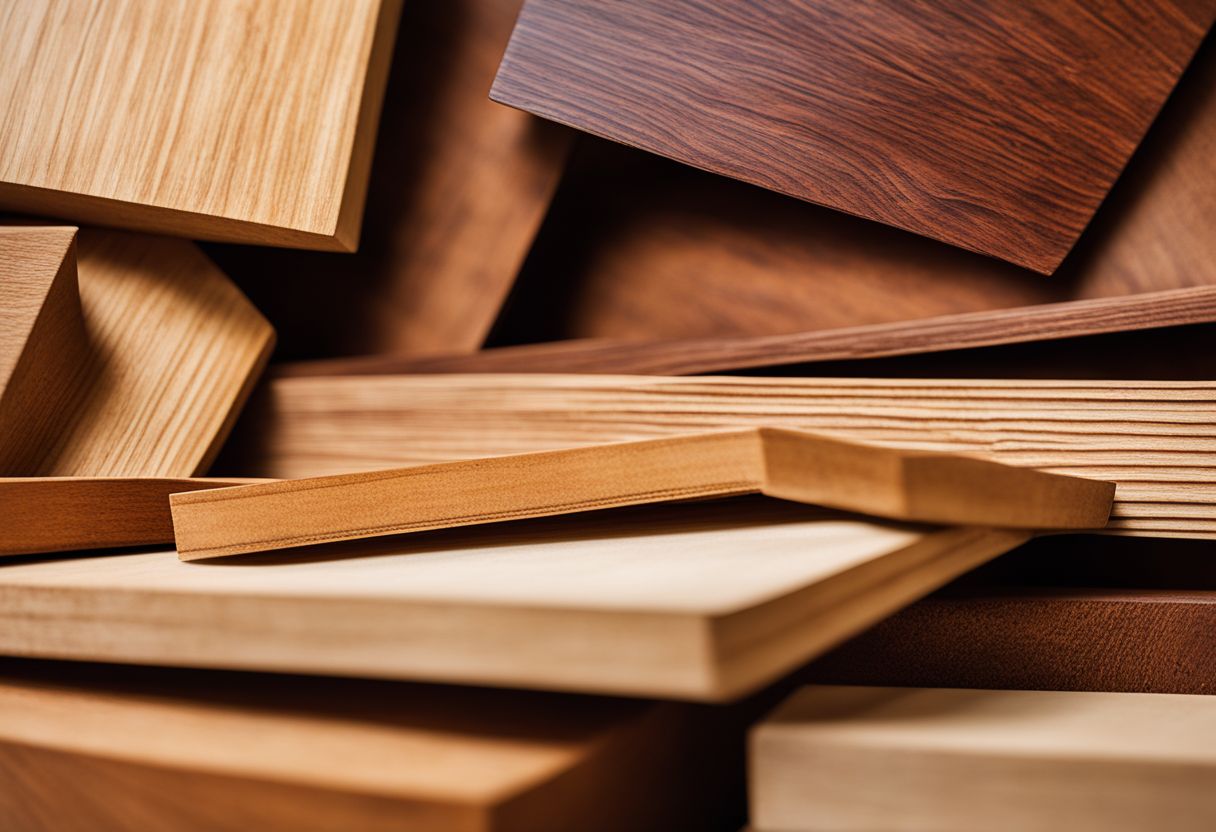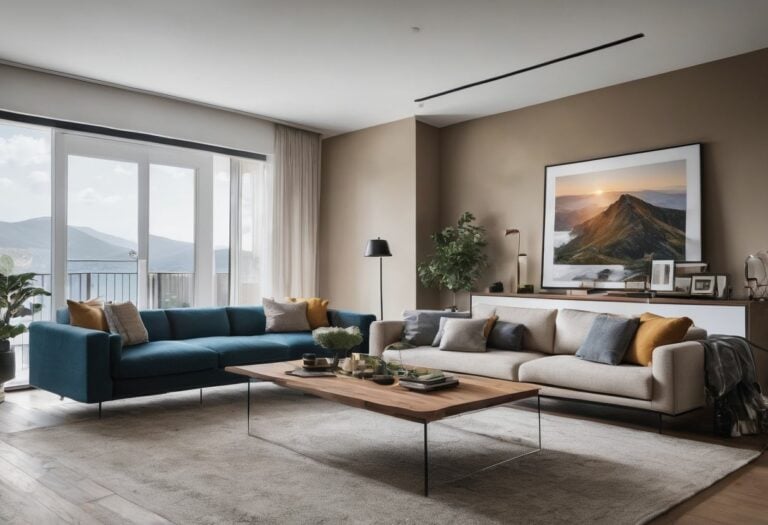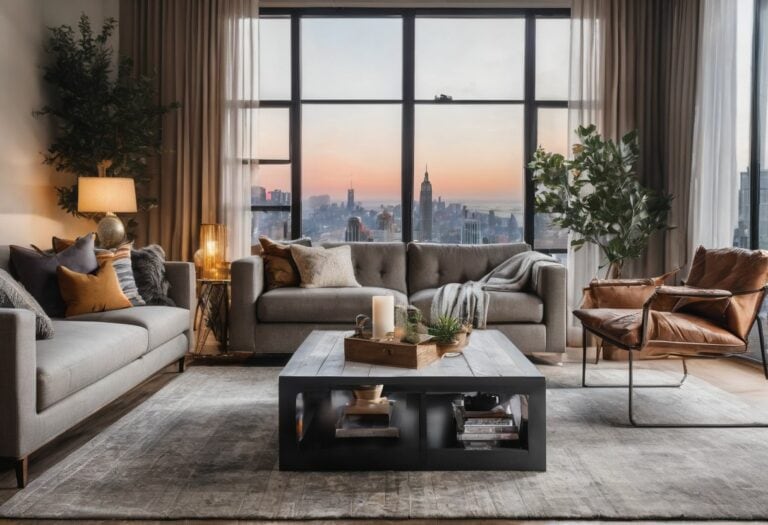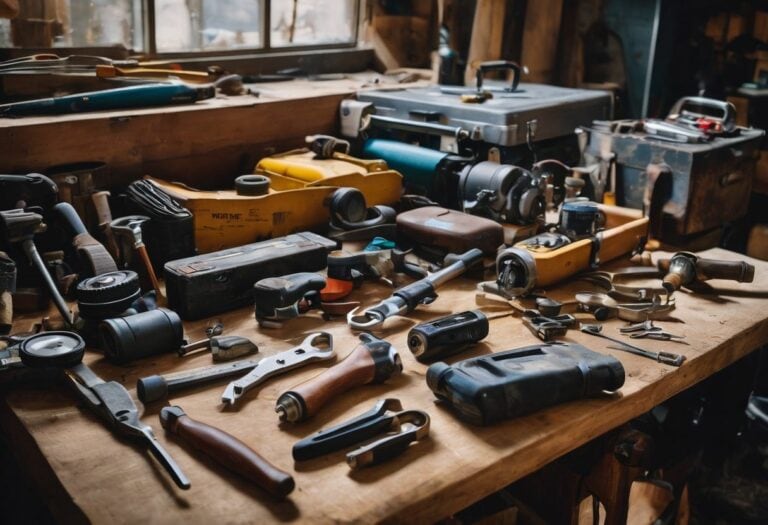Solid Wood vs Engineered Wood Furniture: Ultimate Comparison Guide
Sorting through options of solid vs engineered wood furniture can feel like a tall order, especially when the differences aren’t so clear-cut or you’re not exactly sure what fits your needs.
Believe me, I understand that struggle! That’s why I took it upon myself to spend countless hours researching to decode these perplexing terms and bring some much-needed clarity to this topic.
This blog is brimming with practical insights comparing solid wood and engineered wood furniture – think cost, durability, maintenance, pros & cons – along with key factors you should weigh before making a purchase.
So buckle up for some enlightening revelations that will turn your furniture shopping from intimidating into a walk in the park!
Key Takeaways
- Solid wood furniture is made entirely of real, natural wood and offers exceptional durability and longevity.
- Engineered wood furniture is more affordable and readily available, but may not be as durable or long-lasting as solid wood.
- Factors to consider when choosing between the two include cost, durability, maintenance requirements, aesthetic appeal, and environmental impact.
- Ultimately, the best choice depends on individual preferences, needs, and budget.
Solid Wood vs Engineered Wood Furniture: Definitions and Common Terms

Solid wood refers to furniture made entirely of real, natural wood, while engineered wood is constructed using a combination of natural wood and other materials. Veneer is a thin layer of high-quality wood applied to the surface of furniture, while pressboard, plywood, and particle board are different types of engineered woods commonly used in furniture construction.
Solid Wood
Solid wood is top-notch. It is made from real, natural timber. No tricks, no fakes – just solid lumber all through. This makes it sturdy and great for long-lasting furniture pieces like tables or cabinets.
Its key edge? Durability! Plus, you can tweak or restyle your solid oak desk time after time without worry. Solid Wood also has a rich texture and fine finish that adds charm to any space!
Engineered Wood
Engineered wood is a smart choice for many homes. It’s made by attaching thin pieces of wood together. This makes it strong and able to resist bending or warping, unlike solid wood which can change shape with moisture.
Engineered wood comes in many types including plywood, laminate, particle board and veneer.
The best thing about engineered wood is that it doesn’t cost much money. People who want nice furniture but don’t have a lot of cash will find this helpful. There’s also the fact that this type of wood has no grain pattern like solid timber does.
That means you can paint it any color you like without worrying about hiding its natural beauty.
Veneer
Veneer is a thin layer of fine wood. It is stuck on less costly wood to make furniture look nice. This process gives the end product the same lovely look as solid wood, but for much less money.
Veneer comes from high-quality trees and uses parts that would otherwise go wasted. This makes it good for Earth’s health too! Care needs to be given though, as veneer can scratch or chip if not handled with love and care.
Pressboard
Pressboard is a type of material that is made from sawdust, wood chips, and shavings. It’s engineered using a resin material. You can often find pressboard in pre-fabricated furniture that you put together yourself.
It’s not as strong or durable as solid wood, but it can be more affordable. So if you’re looking for furniture on a budget, pressboard might be an option to consider. However, keep in mind that it may not last as long as solid wood furniture.
Plywood
Plywood is a type of engineered wood that is often used in making furniture. It is made by layering thin sheets of wood together and bonding them with adhesives. Plywood is stronger and denser than particle board, another type of composite wood.
It’s also more resistant to warping caused by moisture compared to solid wood furniture. This makes it a popular choice for building sturdy and durable furniture at a lower cost. So if you’re looking for cost-effective furniture that can withstand different conditions, plywood could be a good option to consider.
Particle Board
Particle board is a type of engineered wood that is made from sawdust, wood chips, and other byproducts from the manufacturing of real wood furniture. It is less dense than natural wood, which means it can be lighter and more affordable.
However, particle board cabinets may not be as durable as solid wood ones. Over time, they can warp, expand, and even crack. So if you’re looking for furniture that will last a long time and withstands wear and tear well, solid wood might be a better option than particle board.
Differences in Construction

Solid wood furniture is made entirely from natural wood, while engineered wood furniture is constructed using a combination of real wood and other materials such as veneer, plywood, or particle board.
Real vs. All vs. Solid Wood
When it comes to furniture, there are different types of wood used in construction. It’s important to understand the differences between real wood, all wood, and solid wood. Real wood refers to any type of natural wood that is used in furniture making.
All wood means that all parts of the furniture, including the frame and panels, are made from real wood. Solid wood means that the entire piece is made from a single piece of natural hardwood or softwood.
Solid wood furniture tends to be more durable and long-lasting compared to other types of wooden furniture. However, it can be susceptible to moisture damage and may require regular maintenance to prevent warping or cracking.
Hardwood vs. Softwood
Hardwood and softwood are two different types of wood used in construction. Hardwood comes from trees that lose their leaves every year, like oak or maple. Softwood comes from evergreen trees, such as pine or cedar.
Hardwoods are generally stronger and more durable because they grow slower than softwoods. Softwoods are commonly used in construction projects because they are easier to work with and less expensive than hardwoods.
However, hardwoods take longer to grow back, making them less renewable compared to softwoods.
Pros and Cons of Solid Wood Furniture
Solid wood furniture offers exceptional durability and longevity, making it a worthwhile investment for those seeking long-lasting pieces. Additionally, the natural texture and finish of solid wood can enhance the overall aesthetic appeal of any space.
However, solid wood furniture tends to be more expensive than its engineered wood counterparts and may not fare well in outdoor environments due to its susceptibility to warping and moisture damage.
Durability and Longevity
Solid wood furniture is known for its exceptional durability and long-lasting quality. When you invest in solid wood furniture, you can expect it to stand the test of time. It is sturdy and resilient, able to withstand daily use without showing signs of wear and tear easily.
Additionally, solid wood furniture has a timeless appeal that never goes out of style, making it a reliable choice for any home decor. You won’t have to worry about replacing your furniture frequently because well-built solid wood pieces can last for many years.
With proper care and maintenance, such as regular dusting and polishing, your high-quality solid wood furniture will continue to look great even after decades of use.
Furniture Texture and Finish
When it comes to furniture texture and finish, solid wood furniture has a natural beauty that is hard to beat. The grain patterns and variations in the wood add depth and character to the piece.
You can feel the texture of the wood when you run your hand over it, creating a tactile experience. On the other hand, engineered wood furniture lacks any specific grain or texture.
It is manufactured to imitate the appearance of real wood but does not offer the same aesthetic appeal as solid timber. So if you value the unique look and feel of real wood, then solid wood furniture may be the better choice for you.
Outdoor Usage
When considering furniture for outdoor use, it’s important to choose materials that can withstand the elements and provide long-lasting durability. Solid wood furniture is an excellent option for outdoor usage because it is easy to maintain and offers incredible strength.
It has natural moisture resistance, which helps prevent damage from rain or humidity. On the other hand, engineered wood furniture, such as MDF (Medium-Density Fiberboard), is not recommended for outdoor use due to its susceptibility to damage and lack of moisture resistance compared to solid wood.
Overall, when selecting furniture for your outdoor spaces, prioritize solid wood for its durability and ability to withstand different weather conditions.
Cost
Solid wood furniture tends to be more expensive than engineered wood furniture. This is because solid wood is made entirely from real wood, which can be pricier to source and manufacture.
On the other hand, engineered wood furniture is composed of a combination of real wood and other materials, such as plywood or particle board. These additional materials help reduce costs and make it more affordable for consumers.
So, if you’re on a tighter budget, you may want to consider engineered wood furniture as a cost-effective option.
It’s important to note that while solid wood furniture may have a higher upfront cost, it often offers better durability and longevity compared to its engineered counterparts. Solid wood furniture can last for many years with proper care, making it a worthwhile investment in the long run.
Pros and Cons of Engineered Wood Furniture
Engineered wood furniture has the advantage of being more readily available and cost-effective compared to solid wood furniture. However, it may not have the same level of durability or longevity as its solid wood counterparts.
Availability and Cost
Engineered wood furniture is a great option if you’re looking for affordability and availability. It’s cheaper than solid wood furniture, making it more budget-friendly. Engineered wood products, like MDF (Medium-Density Fiberboard), are less expensive than natural wood alternatives.
On the other hand, solid wood furniture tends to be pricier due to its durability and design options. So, if cost is a significant factor for you, engineered wood furniture might be the way to go.
Eco-friendliness
When it comes to eco-friendliness, engineered wood has an advantage over solid wood furniture. Engineered wood is made from smaller pieces of wood and bonding agents, which means it uses less natural resources compared to solid wood.
Additionally, engineered wood allows for the use of low-grade and leftover materials that would otherwise go to waste. This makes engineered wood a more sustainable option for those concerned about the environment.
However, it’s important to note that some components used in the creation of engineered wood may contain chemicals or formaldehyde-based adhesives, which can have negative effects on indoor air quality.
Weight and Mobility
Engineered wood furniture is a great choice if you want lightweight furniture that’s easy to move around. Unlike solid wood furniture, which can be quite heavy, engineered wood is designed to be lighter.
This makes it easier for you to rearrange your furniture or even move it to a different room if you need to. So if you value mobility and want furniture that’s easy to handle, engineered wood might be the way to go.
The light weight of engineered wood furniture has its advantages. It means that you won’t have to struggle when moving your furniture around or when it comes time for cleaning or redecorating.
Plus, if you ever decide to relocate or rearrange your living space, transporting your lightweight engineered wood pieces will be much easier compared to heavier solid wood ones.
However, while the weight and mobility of engineered wood are definite pluses, there are also some considerations to keep in mind. Because it is lighter in weight, some people may perceive it as less sturdy than solid wood.
Factors to Consider
When choosing between solid wood and engineered wood furniture, it is important to consider your lifestyle and the purpose and usage of the furniture.
Lifestyle
Considering your lifestyle is an important factor when choosing between solid wood and engineered wood furniture. If you have a busy household with children or pets, durability becomes crucial.
Solid wood furniture offers long-lasting durability and can withstand the wear and tear of everyday use. On the other hand, if you prefer to change your furniture more frequently or have a more budget-friendly approach, engineered wood furniture may be a better option.
It provides affordable alternatives without compromising on quality and can still offer sturdy construction. Ultimately, your lifestyle needs should guide your decision-making process when it comes to selecting the right type of furniture for your home.
Purpose and Usage
When considering furniture, it’s important to think about its purpose and how you’ll use it. Will it be for everyday use in a busy household or for occasional use in a formal setting? The intended usage of the furniture will help determine whether solid wood or engineered wood is the better choice.
For example, if you need sturdy and durable furniture that can withstand heavy daily use, solid wood may be the way to go. On the other hand, if cost-effectiveness and versatility are more important factors for you, engineered wood might be a better fit.
Considering your lifestyle and specific needs will help guide you towards making the right decision when choosing between solid wood and engineered wood furniture.
Maintenance and Care
Taking care of your furniture is important to ensure its longevity and keep it looking its best. Here are some tips for maintaining and caring for both solid wood and engineered wood furniture:
- Regular Cleaning: Both types of furniture can be cleaned using a soft cloth or microfiber duster to remove dust and dirt. You can also use a mild soap solution for deeper cleaning, but make sure to dry the furniture thoroughly afterwards.
- Avoid Direct Sunlight: Excessive sunlight exposure can cause fading and damage to both solid wood and engineered wood. Use curtains or blinds to protect your furniture from direct sunlight, especially if it’s placed near windows.
- Use Coasters and Mats: To prevent water rings, scratches, and heat damage, always use coasters, placemats, or trivets when placing hot or cold items on your furniture. This applies to both types of wood.
- Repair Scratches: If you notice any scratches on your furniture’s surface, you can try using a touch-up kit or filler specifically designed for wood repairs. This will help minimize the appearance of scratches on both solid wood and engineered wood.
- Avoid Harsh Chemicals: When cleaning or polishing your furniture, avoid using harsh chemicals or abrasive cleaners as they can damage the finish. Stick to mild soaps or specifically formulated wood cleaners that are safe for both types of wood.
- Moisture Control: Ensure that the humidity levels in your home are within a recommended range (usually between 40% – 60%) to prevent warping or cracking of the wood. Use humidifiers in dry climates and dehumidifiers in humid environments as needed.
- Regular Maintenance: Periodically inspect your furniture for loose screws or fittings and tighten them if necessary. This applies to both solid wood and engineered wood pieces.
Comparing the Two Types of Furniture
When comparing solid wood and engineered wood furniture, factors such as durability, aesthetic appeal, and suitability for different environments play a crucial role in making the right choice.
By understanding these aspects, you can confidently select the perfect type of furniture for your needs.
Durability
Solid wood furniture is known for its durability and long-lasting nature. It is made from real wood, which gives it strength and robustness. Solid wood furniture can withstand wear and tear, making it a reliable choice that will last for many years.
On the other hand, engineered wood furniture has also improved in terms of durability over time. While not as sturdy as solid wood, engineered wood furniture is still built to be resilient and tough.
It may not be as long-lasting as solid wood, but with proper care, it can still provide good endurance. When choosing between solid wood and engineered wood furniture, considering the level of durability you need for your lifestyle and intended usage is important in making the right choice.
Aesthetic Appeal
For many people, the way furniture looks is just as important as how it functions. When it comes to wooden furniture, aesthetic appeal plays a big role. The texture of the wood, the finish on its surface, and the natural patterns in the grain all contribute to its visual attractiveness.
These elements can make a piece of furniture stand out and add decorative beauty to any room. Whether you prefer a modern or traditional style, wooden furniture has an artistic charm that is hard to resist.
Its elegance and grace can create an eye-catching focal point in your home, showcasing your personal style and creating a pleasing atmosphere. So when choosing between solid wood and engineered wood furniture, consider not only their durability but also their ability to enhance the overall look of your living space.
Suitability for Different Environments
When considering the suitability of solid wood and engineered wood furniture for different environments, there are a few factors to keep in mind. Solid wood furniture is known for its durability and longevity, making it a good choice for various settings.
However, it can be quite pricey compared to engineered wood furniture. On the other hand, engineered wood furniture offers some resistance to moisture, which makes it more suitable for environments with higher humidity levels.
It’s important to consider the intended environment and the specific needs of your space when choosing between solid wood and engineered wood furniture.
Making the Right Choice
When deciding between solid wood and engineered wood furniture, it is important to consider factors such as identifying the type of wood used, price comparison, and specific considerations for different uses.
Identifying Engineered Wood
Engineered wood can sometimes be mistaken for solid wood, but there are ways to identify it. Here are some key points to consider when trying to identify engineered wood:
- Look for layers: Engineered wood is made up of multiple layers, whereas solid wood is one continuous piece. Look closely at the edges or cross-section of the furniture to see if you can spot any layers.
- Check for a veneer: Engineered wood often has a thin layer of real wood, called a veneer, applied on top for aesthetics. This can give it the appearance of solid wood. Examine the surface closely to see if you can detect any seams or variations in grain pattern that might indicate a veneer.
- Consider weight: Engineered wood tends to be lighter than solid wood due to its construction with various materials. If the furniture feels noticeably lighter than you would expect for its size, it could be engineered wood.
- Look for consistency: Solid wood will typically have a consistent grain pattern throughout, while engineered wood may have repeating patterns or inconsistencies in the grain due to the use of different materials.
- Examine end grains: Solid wood will show growth rings and variation in color and texture at the ends, while engineered wood may appear more uniform and consistent.
Price Comparison
The difference in cost between engineered wood and solid wood furniture is an essential consideration for many buyers. Below is a comparison table showing the general price ranges for both types, accounting for factors such as the design, size, brand, and overall quality.
| Type of Wood | Low-End Prices | Mid-Range Prices | High-End Prices |
|---|---|---|---|
| Solid Wood Furniture | $500+ | $1,500 – $3,000 | $3,500 and above |
| Engineered Wood Furniture | $100 – $300 | $400 – $800 | $1,000 – $2,000 |
Remember, solid wood furniture can be pricier due to its durability and design flexibility. On the other hand, engineered wood pieces tend to be more affordable, making them an attractive option for those on a budget. However, the bottom line is to decide based on what best suits your needs, preferences, and budget.
Considerations for Different Uses
When choosing between solid wood and engineered wood furniture, it’s important to consider the specific uses you have in mind. Here are some key factors to keep in mind:
- Durability: Solid wood furniture is known for its strength and durability, making it a good choice for high-traffic areas or households with active children or pets. Engineered wood furniture may be more susceptible to wear and tear over time.
- Cost: Solid wood furniture is often more expensive than engineered wood options. If budget is a concern, you may want to consider the cost-effectiveness of engineered wood furniture.
- Toxicity: Some engineered wood products contain chemicals like formaldehyde, which can emit harmful fumes into the air. If you are concerned about indoor air quality, consider opting for solid wood furniture that has been made with non-toxic finishes.
- Aesthetic Appeal: The natural beauty and unique characteristics of solid wood lend themselves well to creating a warm and inviting atmosphere in your home. Engineered wood furniture can also be quite attractive, but it may lack some of the natural charm found in solid wood pieces.
- Suitability for Different Environments: Consider where the furniture will be placed in your home. Solid wood furniture can handle outdoor elements better than most engineered wood options, making it a great choice for patio or garden furniture.
Conclusion
In conclusion, when choosing between solid wood and engineered wood furniture, it’s important to consider factors such as durability, cost, maintenance, and design flexibility. Solid wood furniture offers incredible durability but can be pricey.
Engineered wood is a more affordable option but may not last as long. Ultimately, the right choice depends on your individual preferences and needs. Consider what matters most to you and make an informed decision that fits your lifestyle.
FAQs
1. What is the difference between solid wood and engineered wood furniture?
Solid wood furniture is made from natural, whole pieces of wood, while engineered wood is made by combining multiple layers of wood veneers or fibers.
2. What are the pros of solid wood furniture?
Solid wood furniture has a timeless appeal, durability, and can be refinished to restore its original beauty.
3. What are the cons of solid wood furniture?
Solid wood may be more expensive than engineered wood and can be susceptible to warping or cracking in humid environments.
4. What are the pros of engineered wood furniture?
Engineered wood is often more affordable, can be stronger than solid wood in some cases, and it is less likely to warp or crack due to changes in humidity.
5. What factors should I consider when choosing between solid and engineered woods for my furniture?
Factors such as budget, preferred style, intended use, environmental impact, and personal preference for natural materials should all be considered when making a decision between solid and engineered woods for your furniture.







